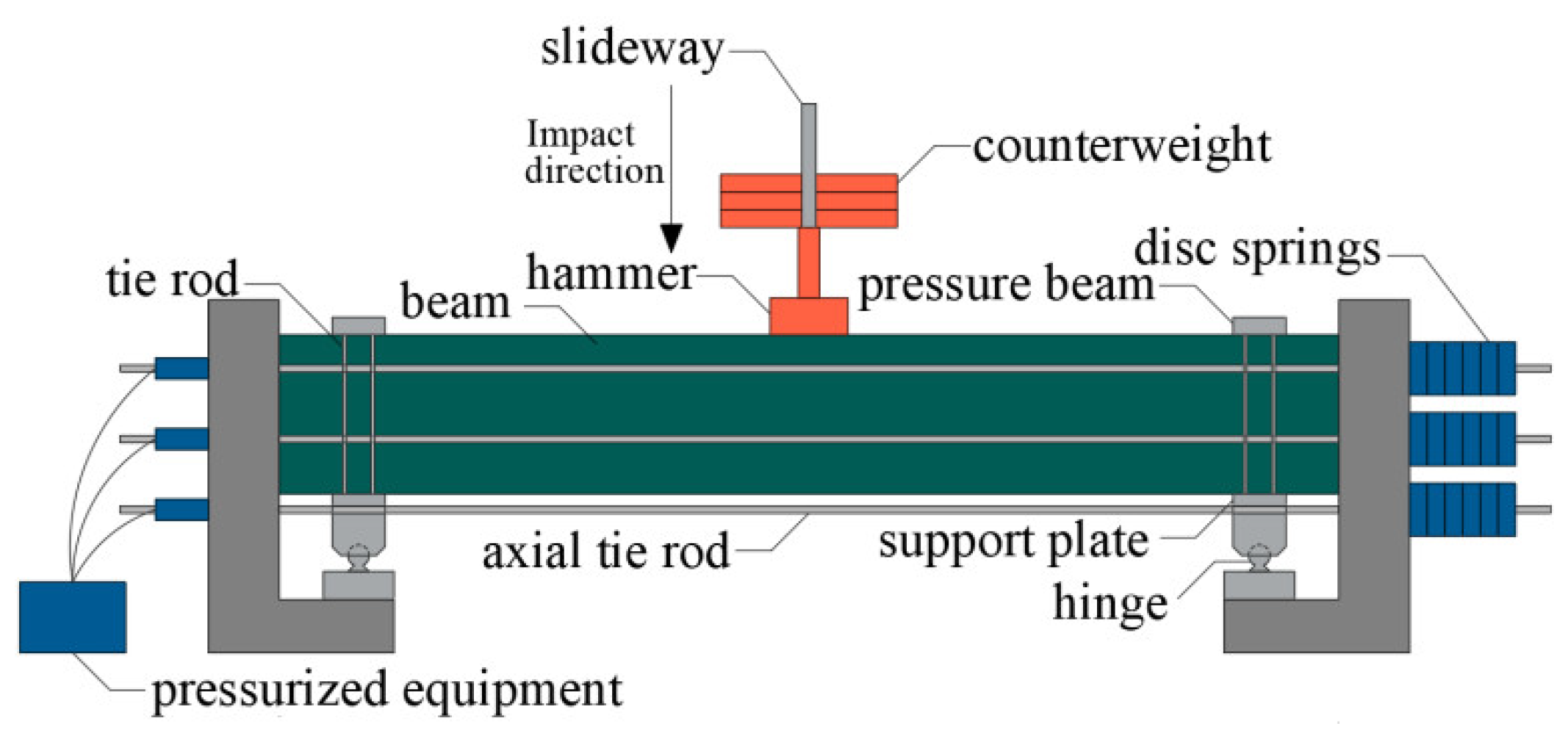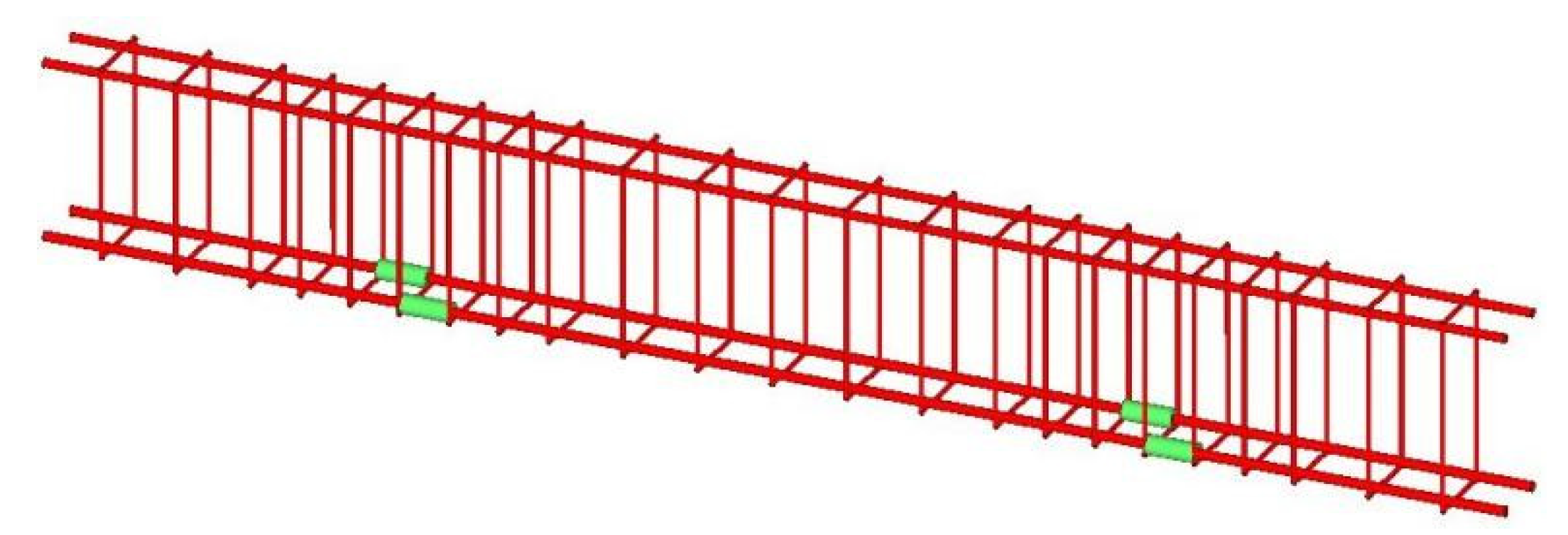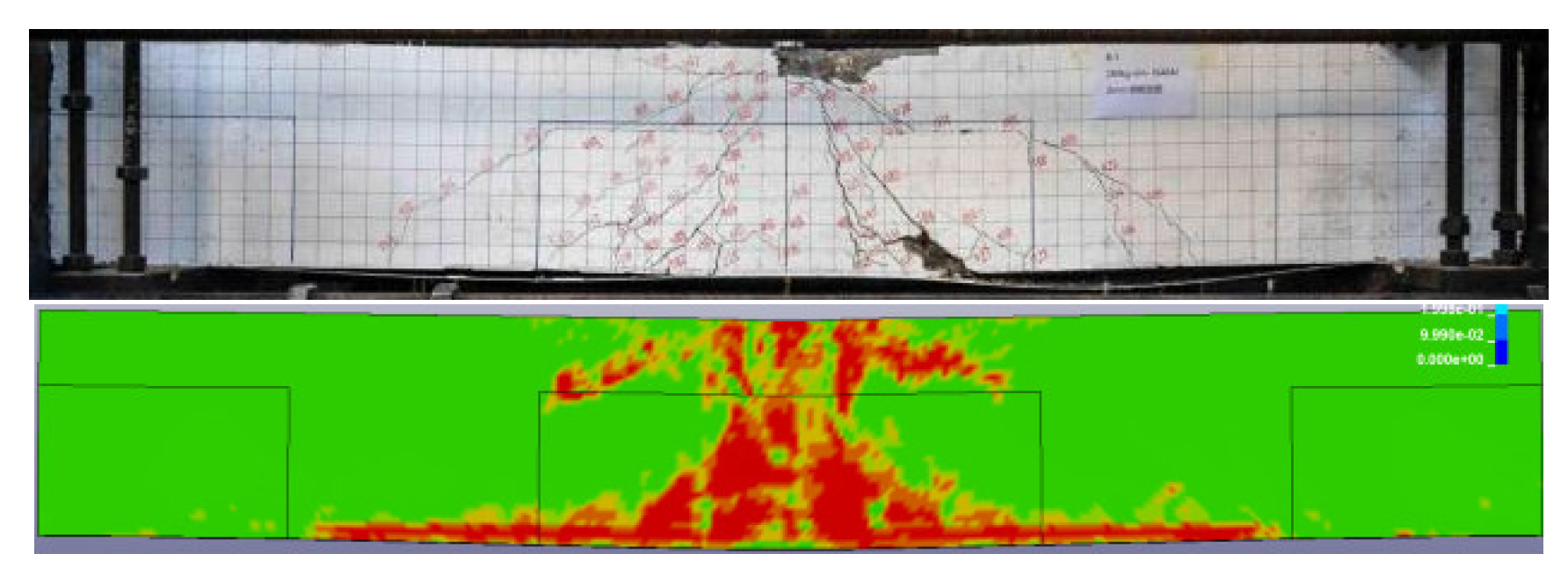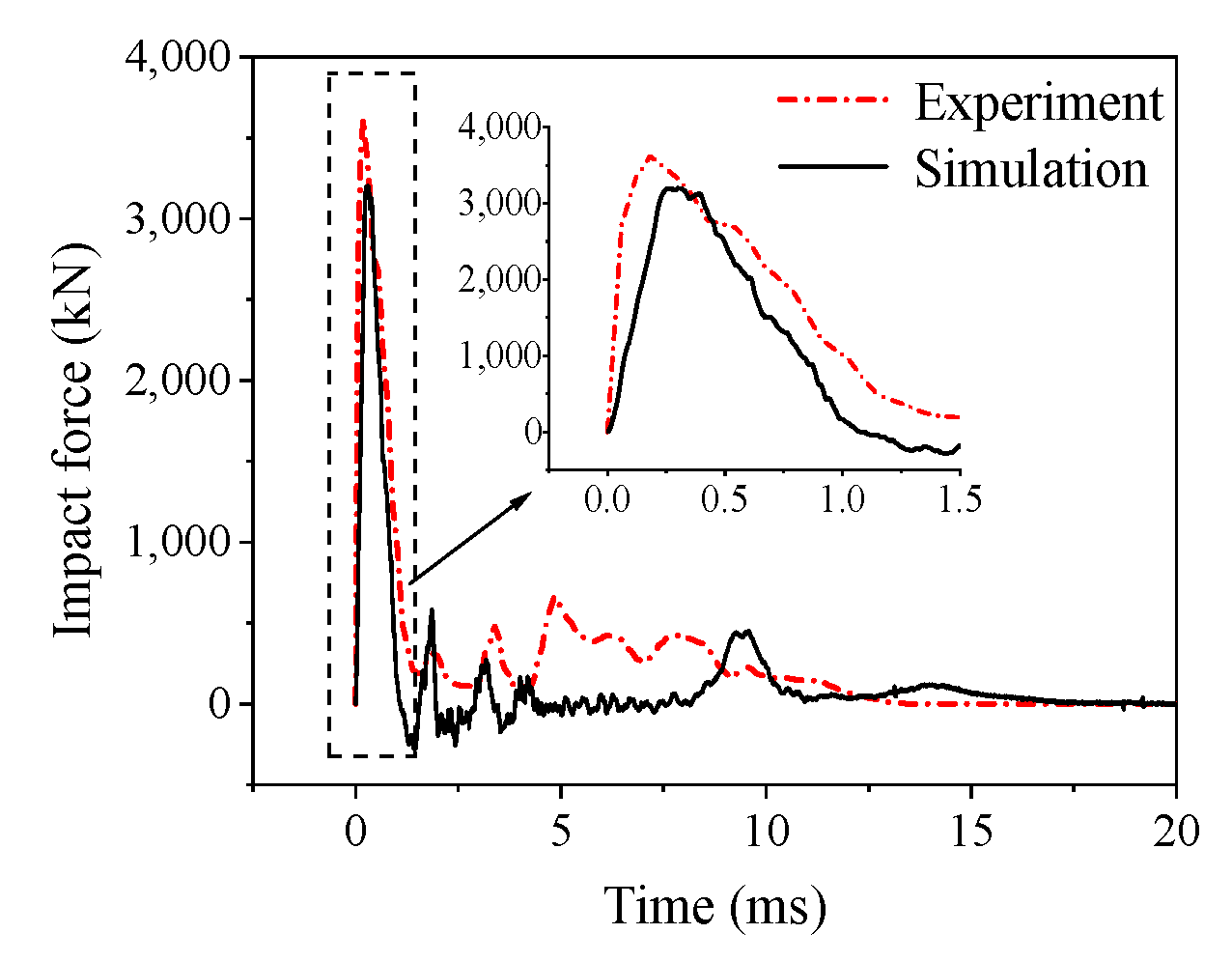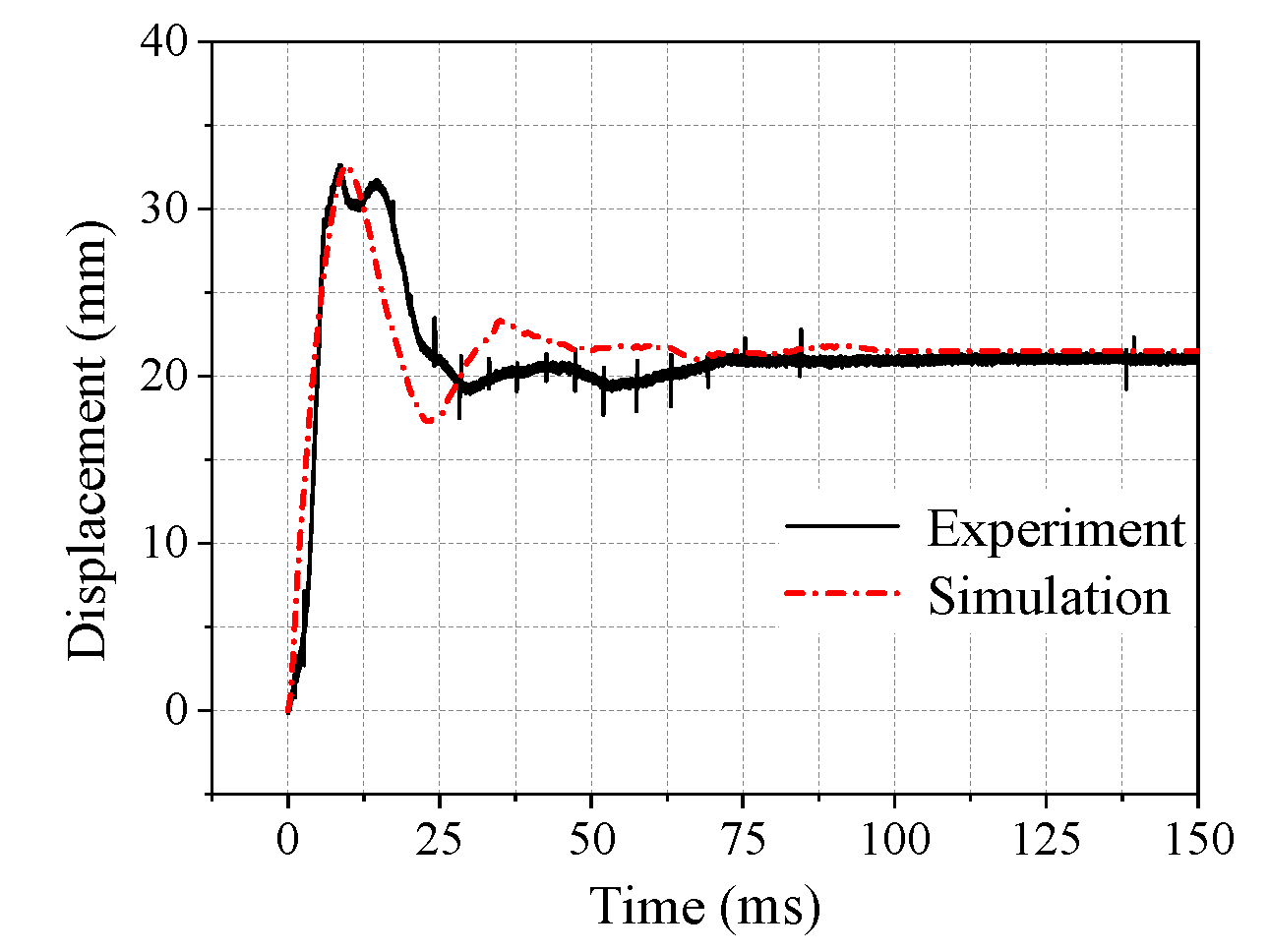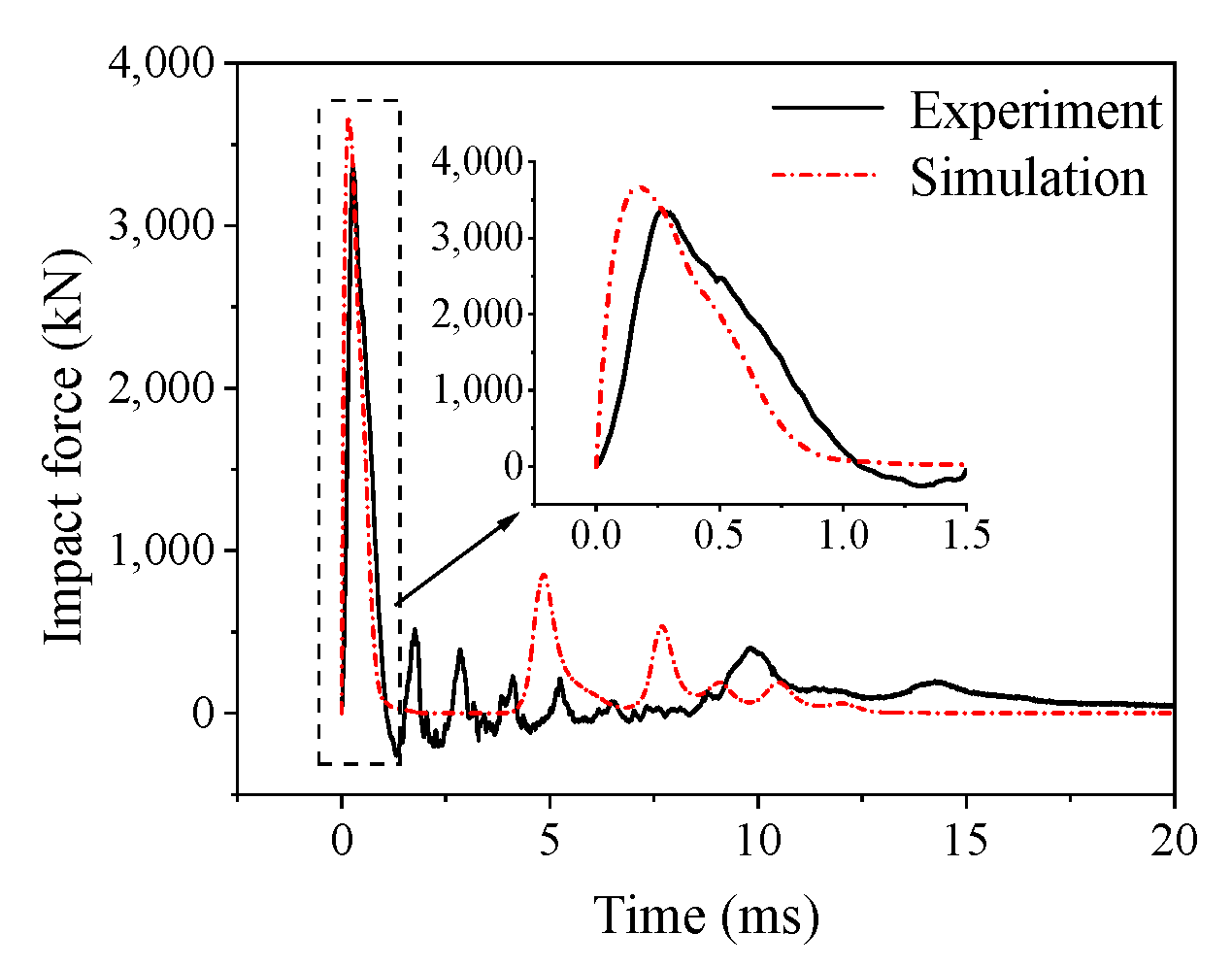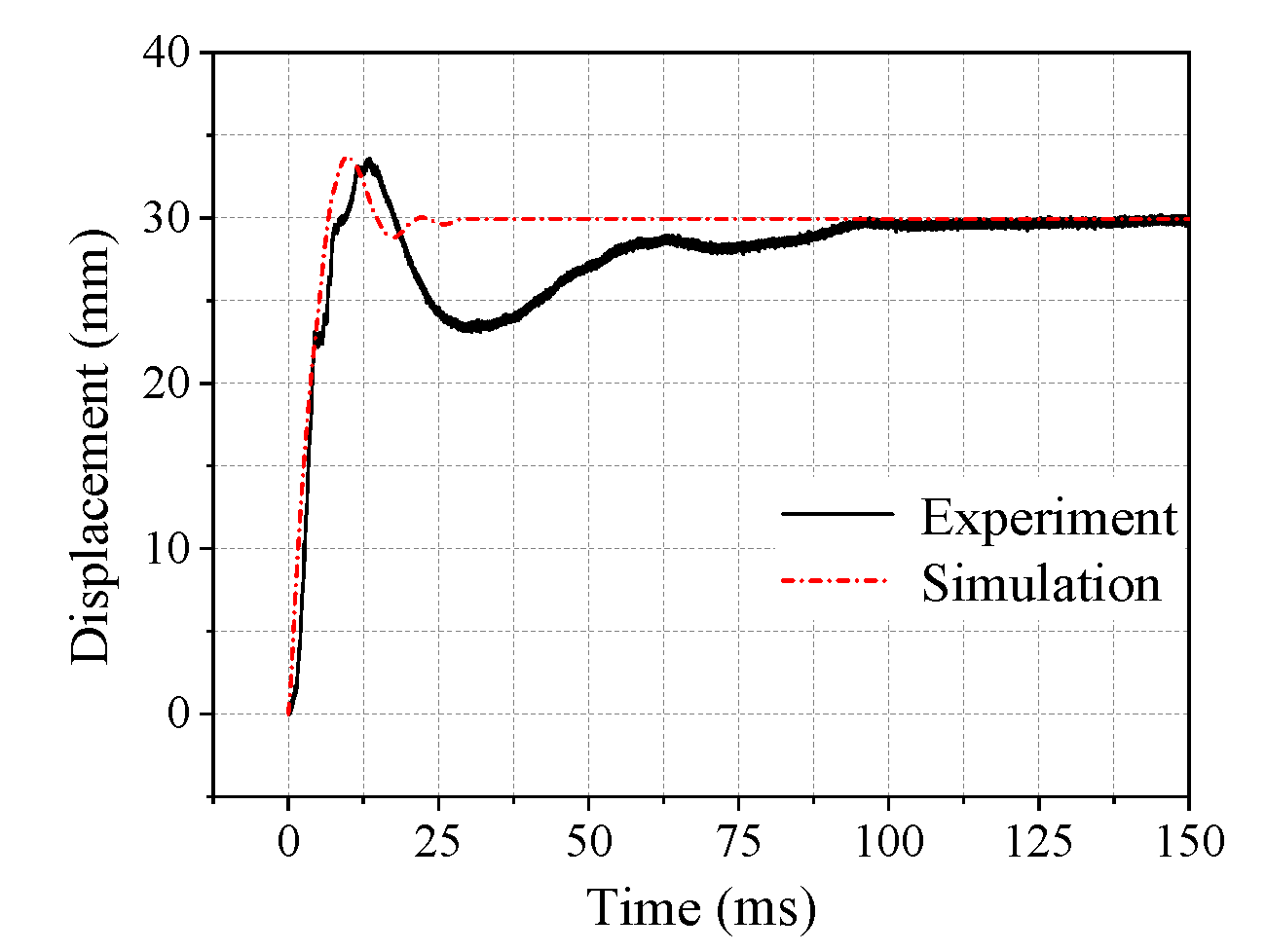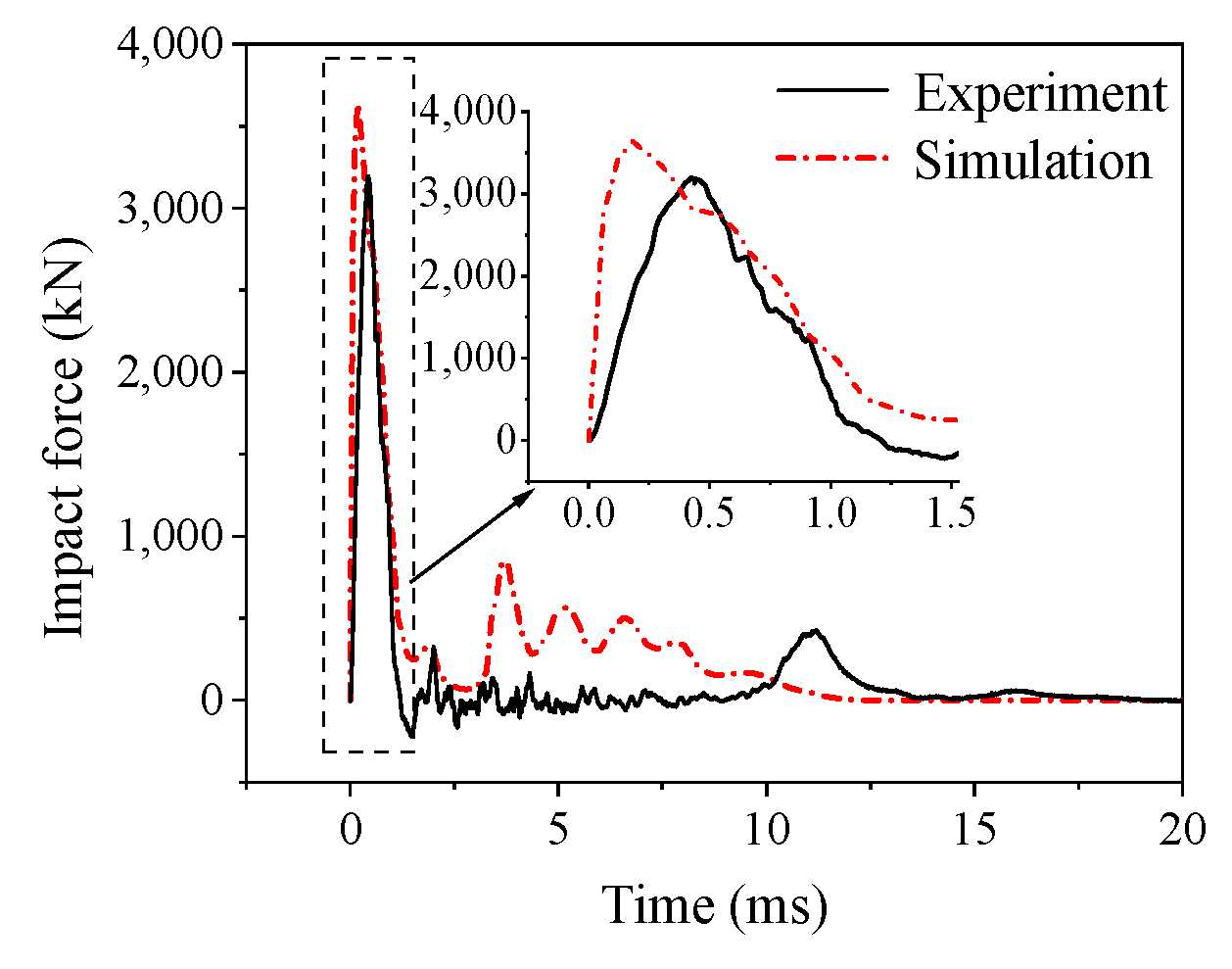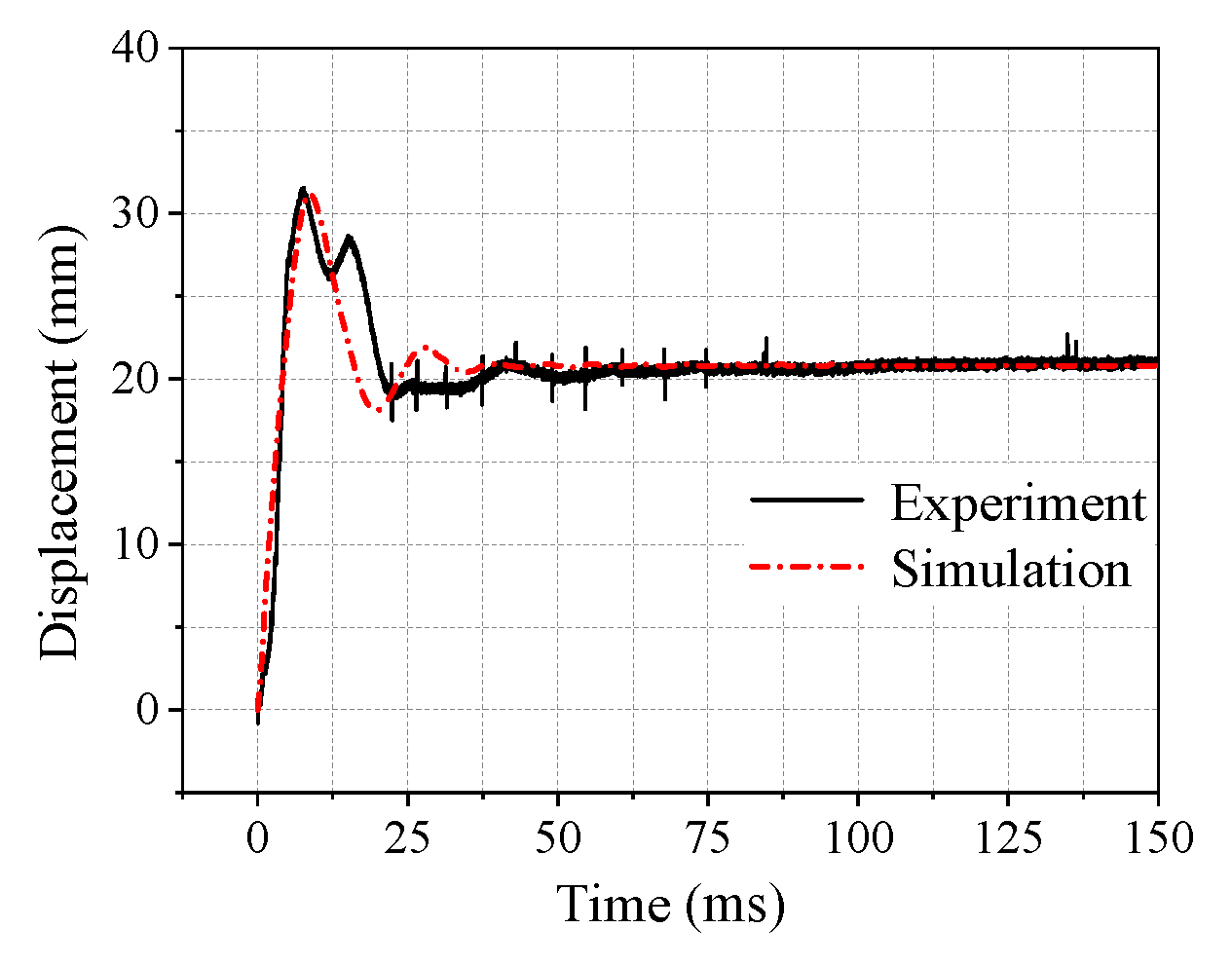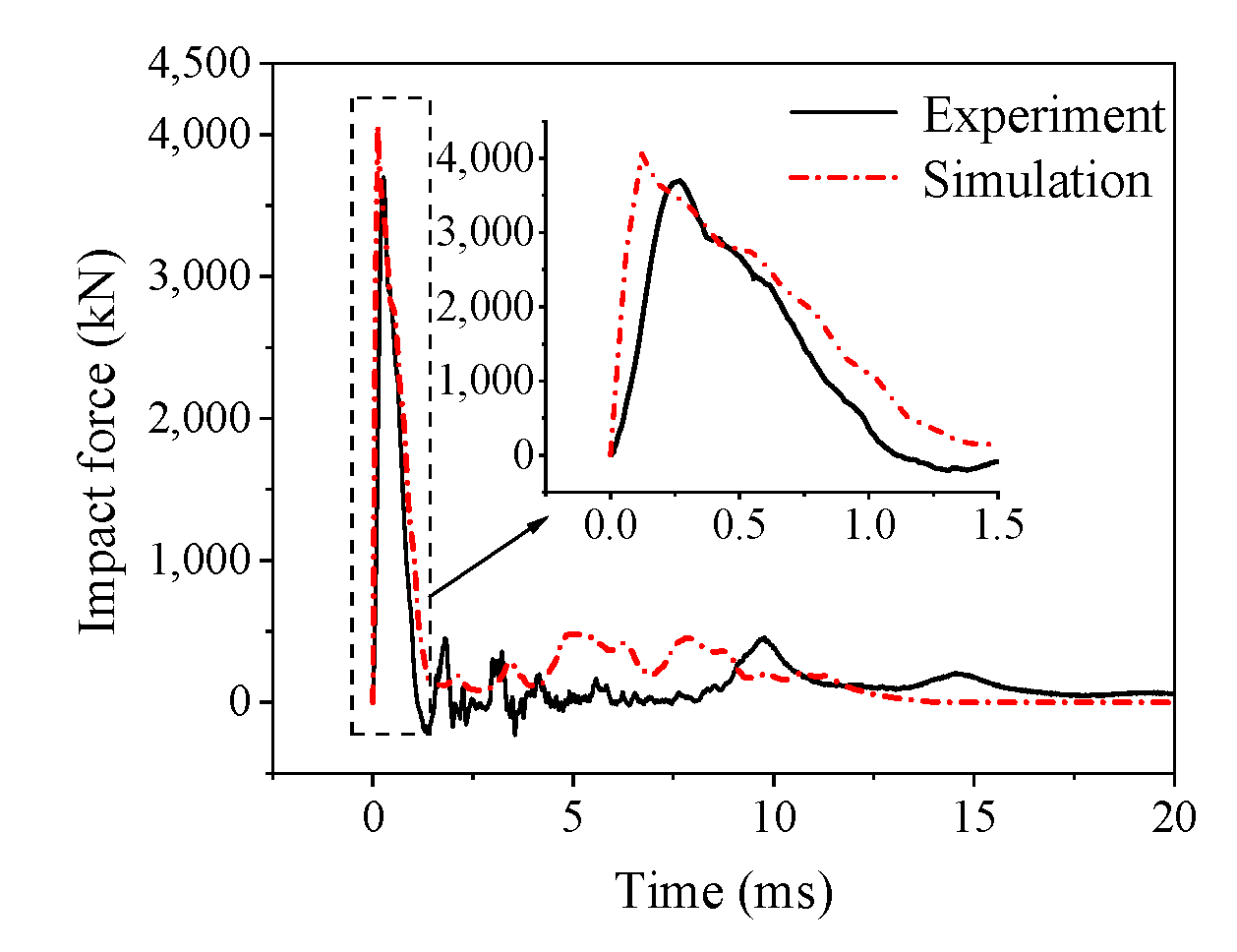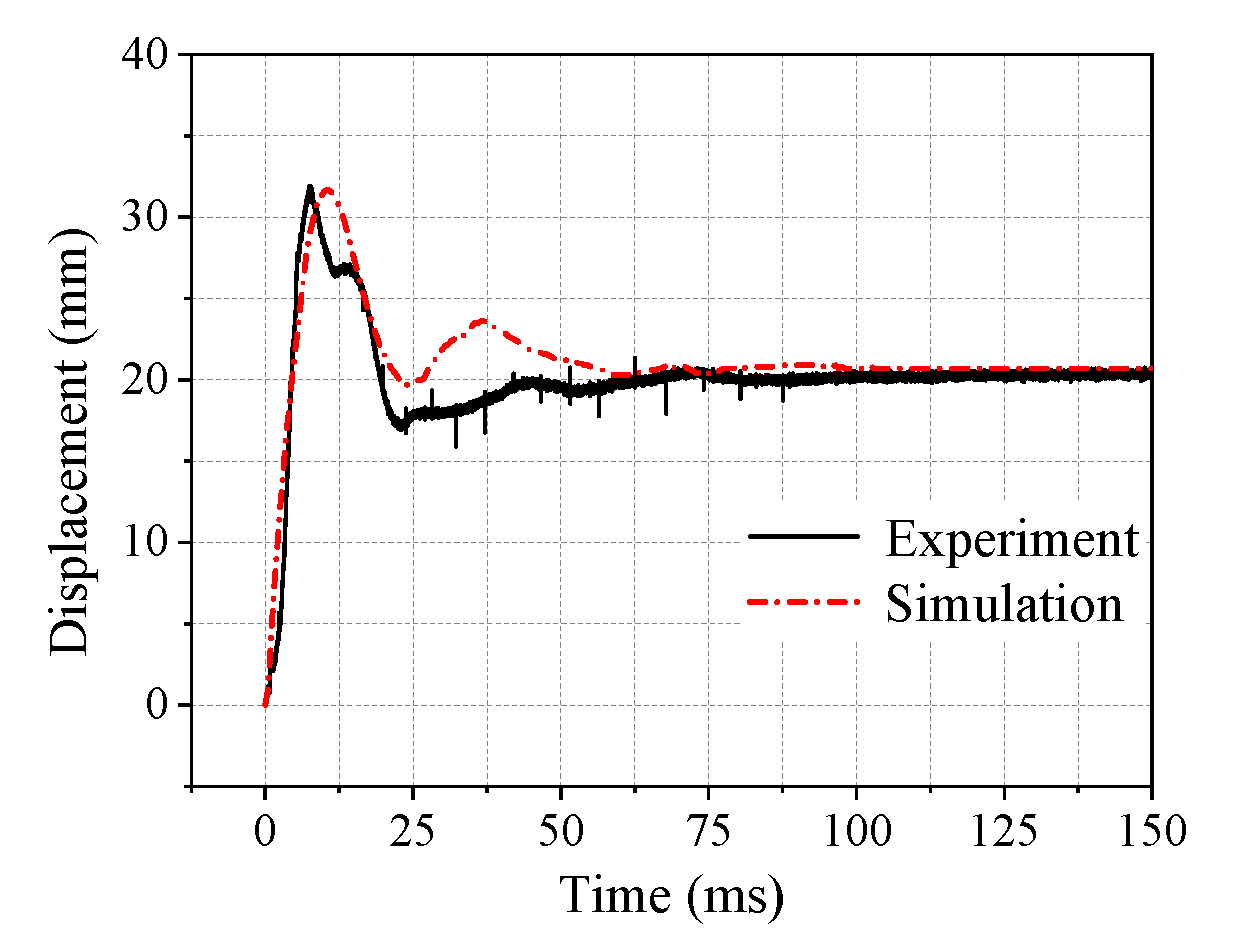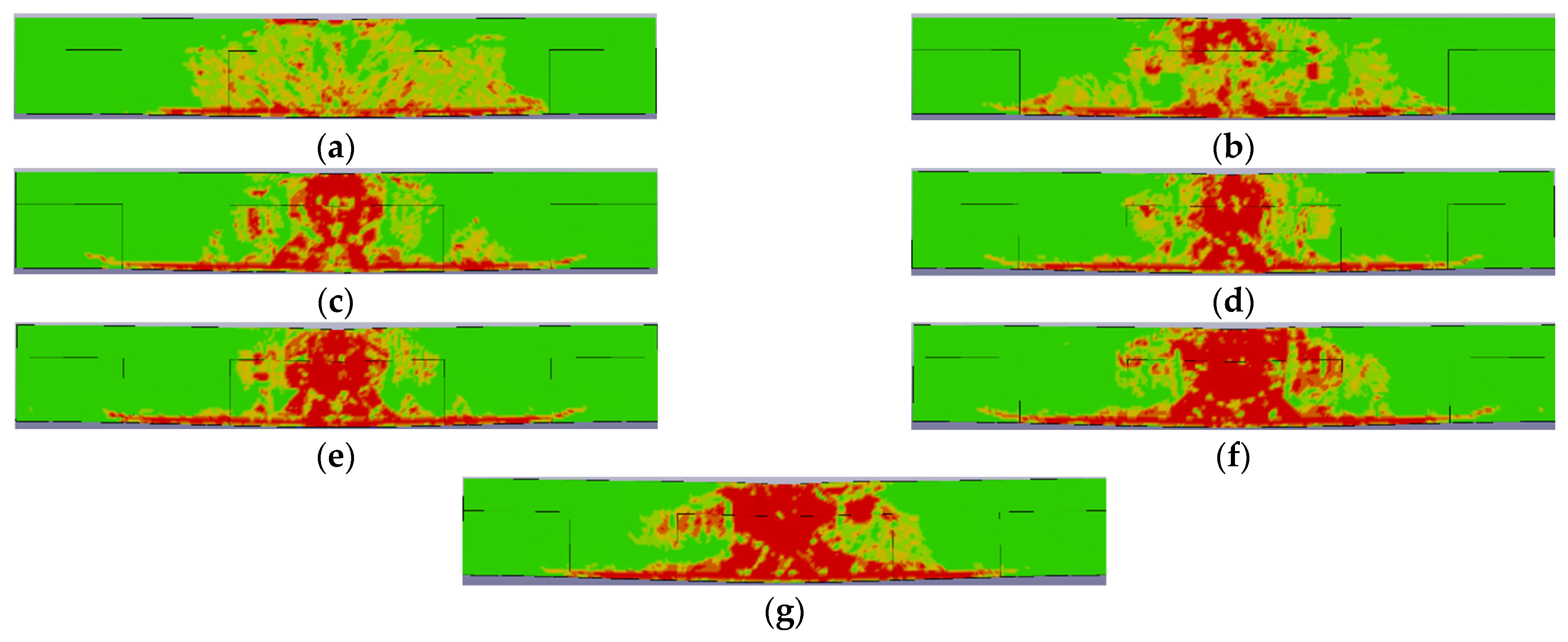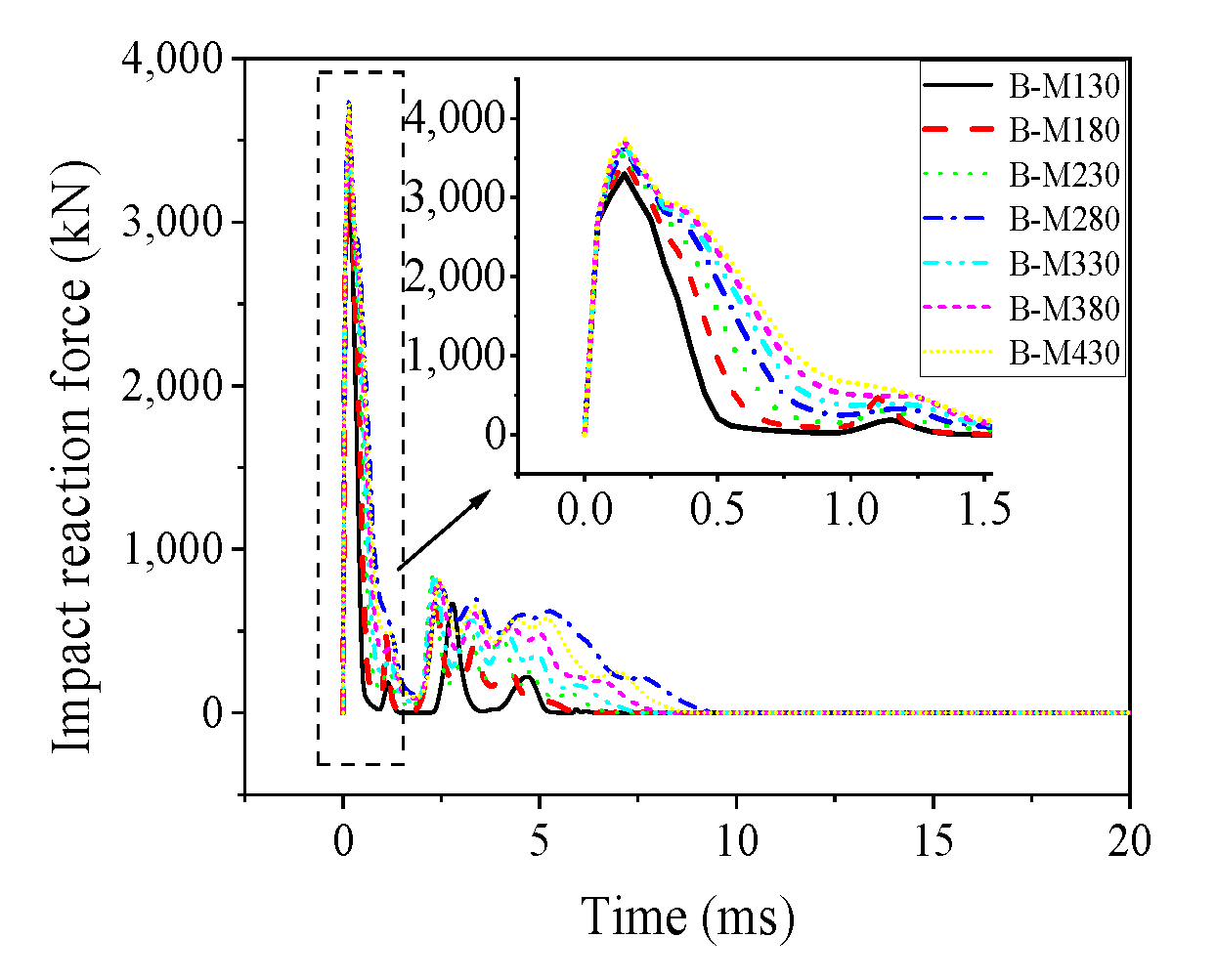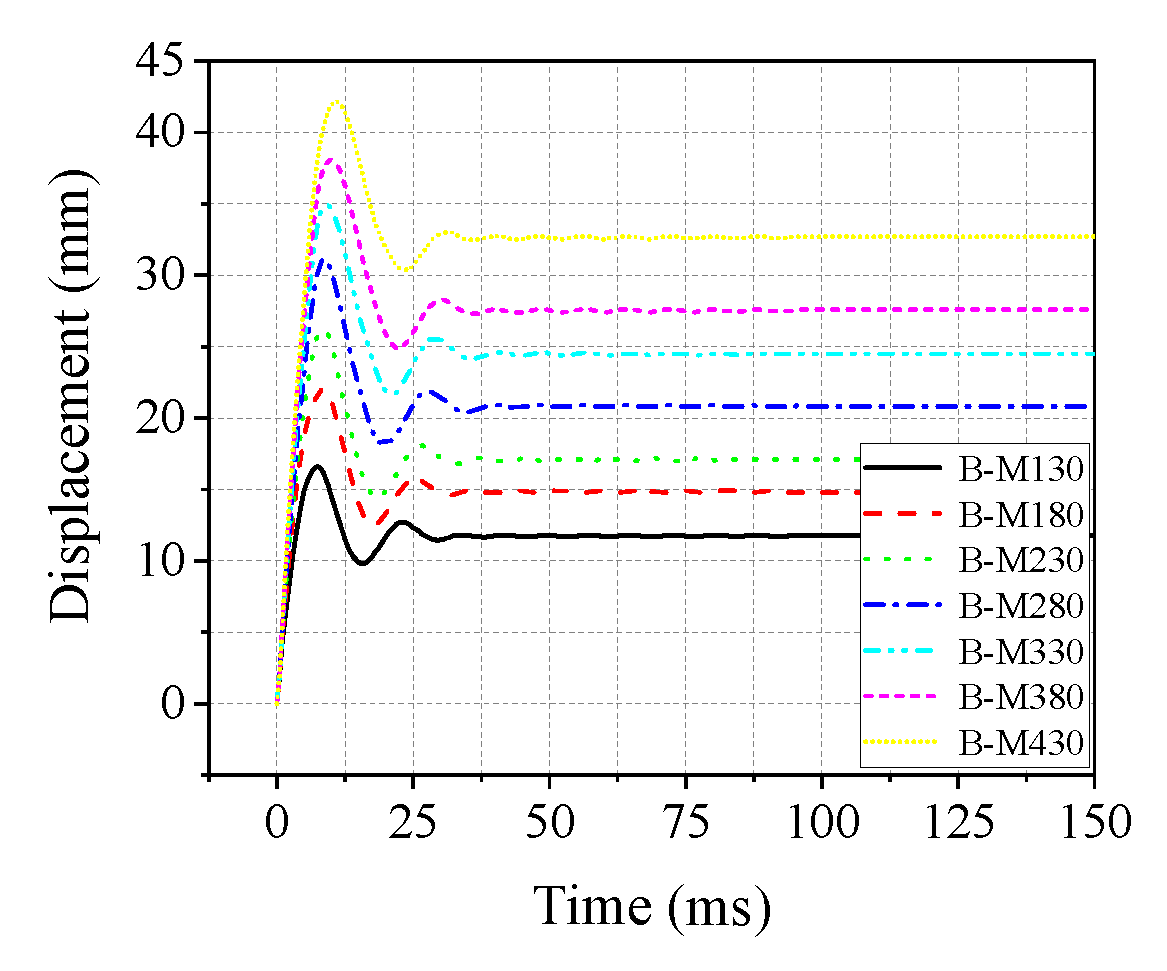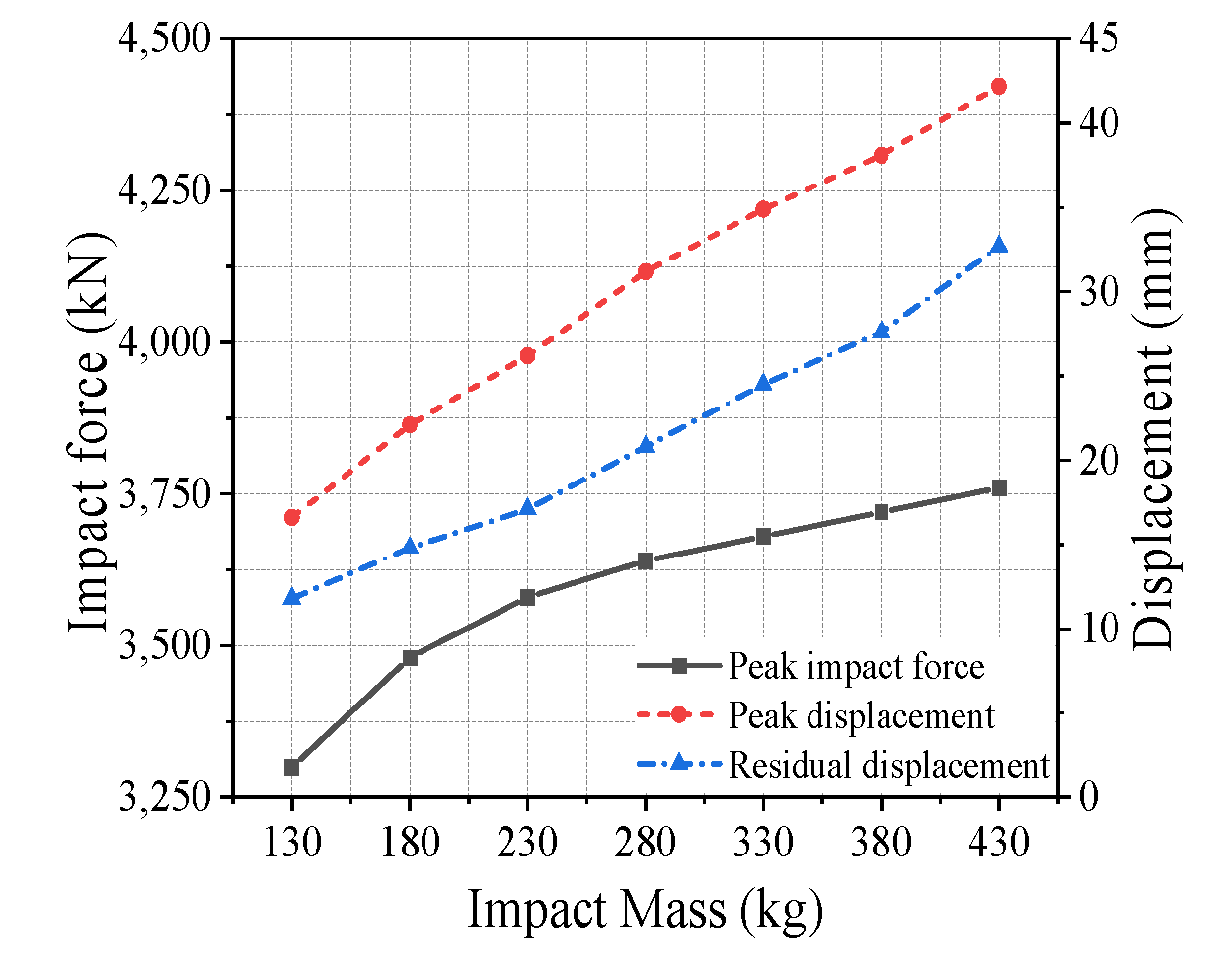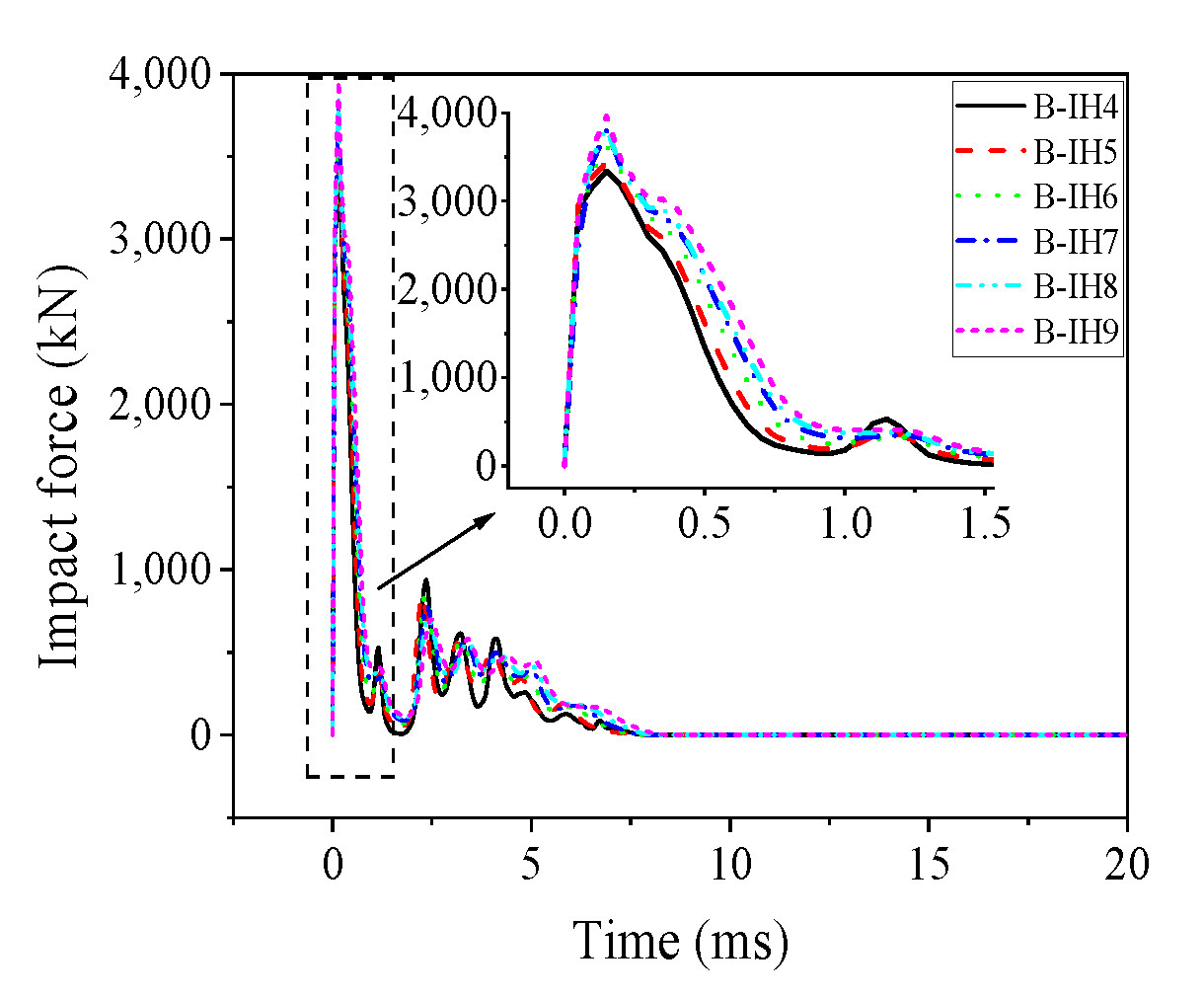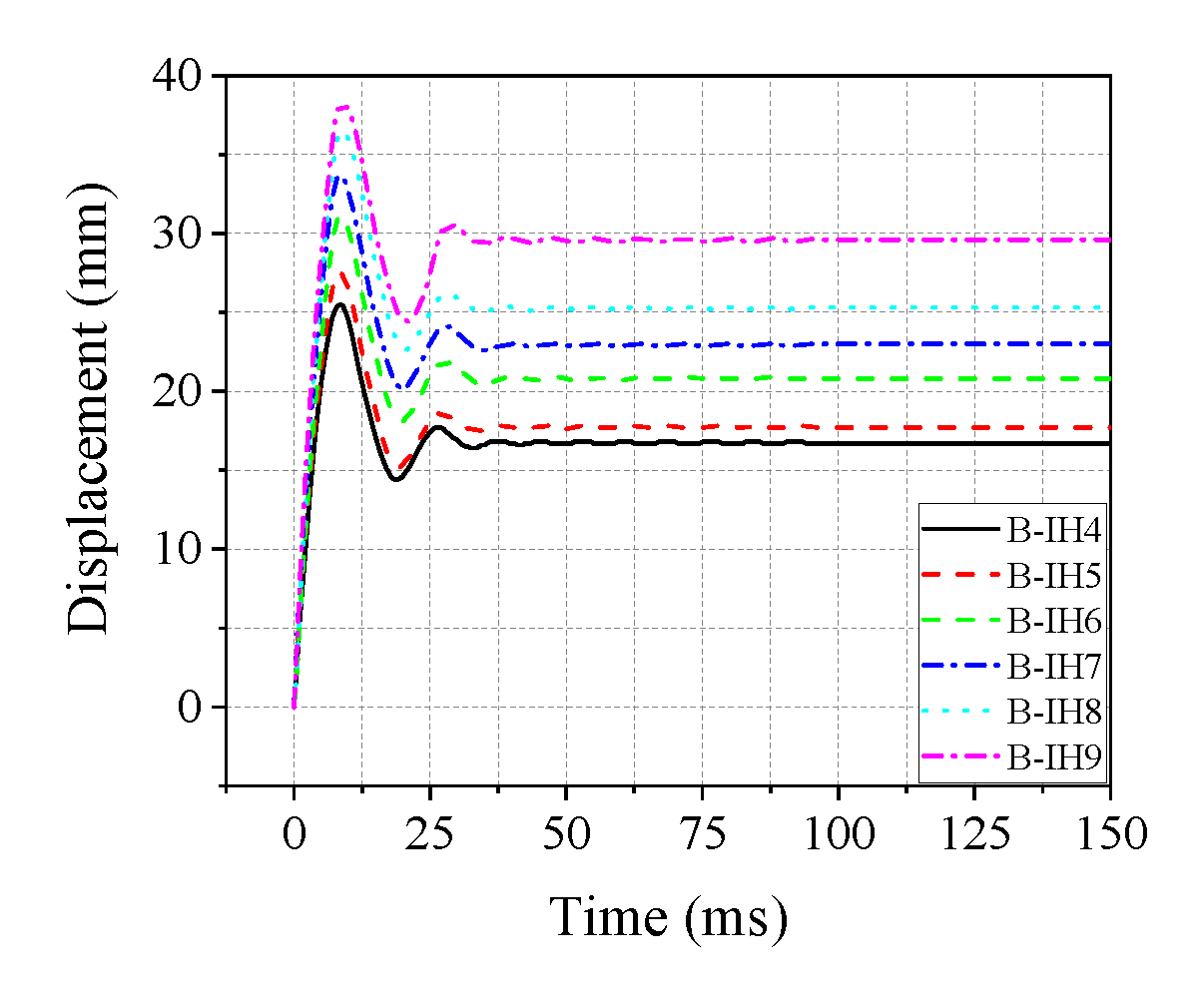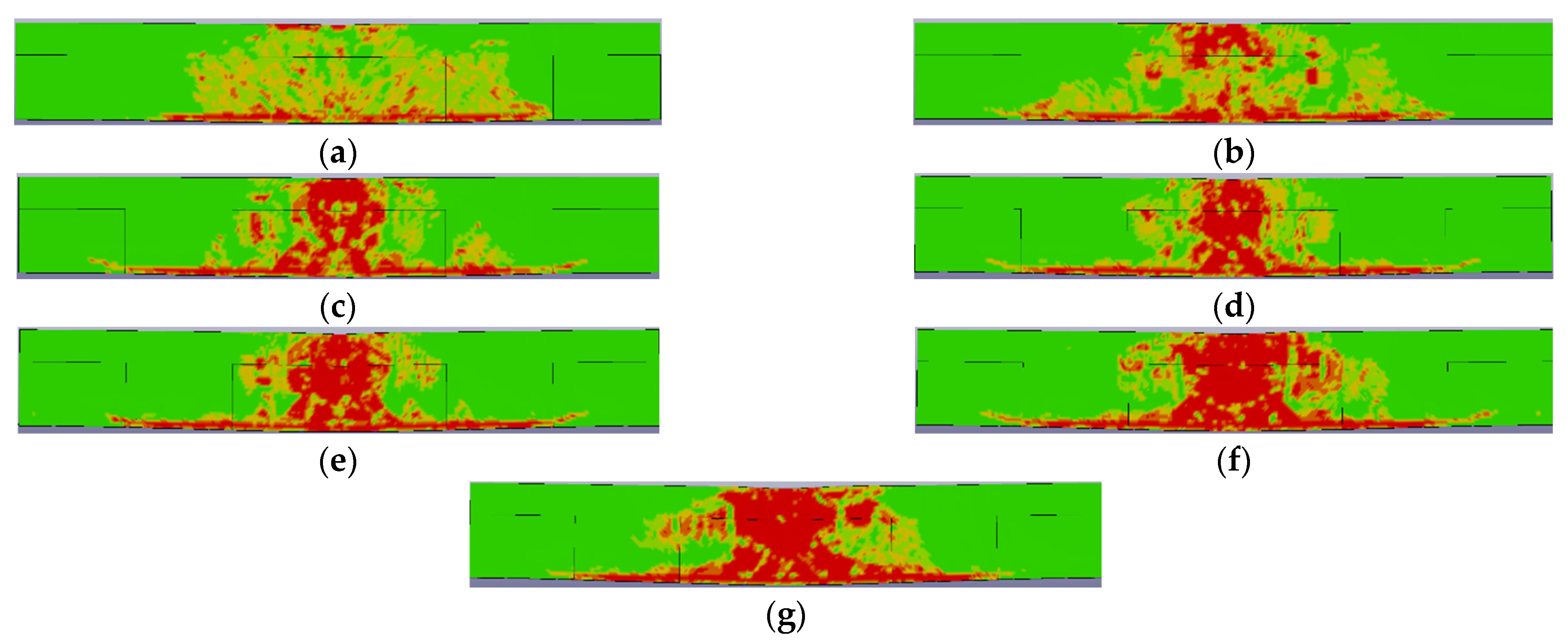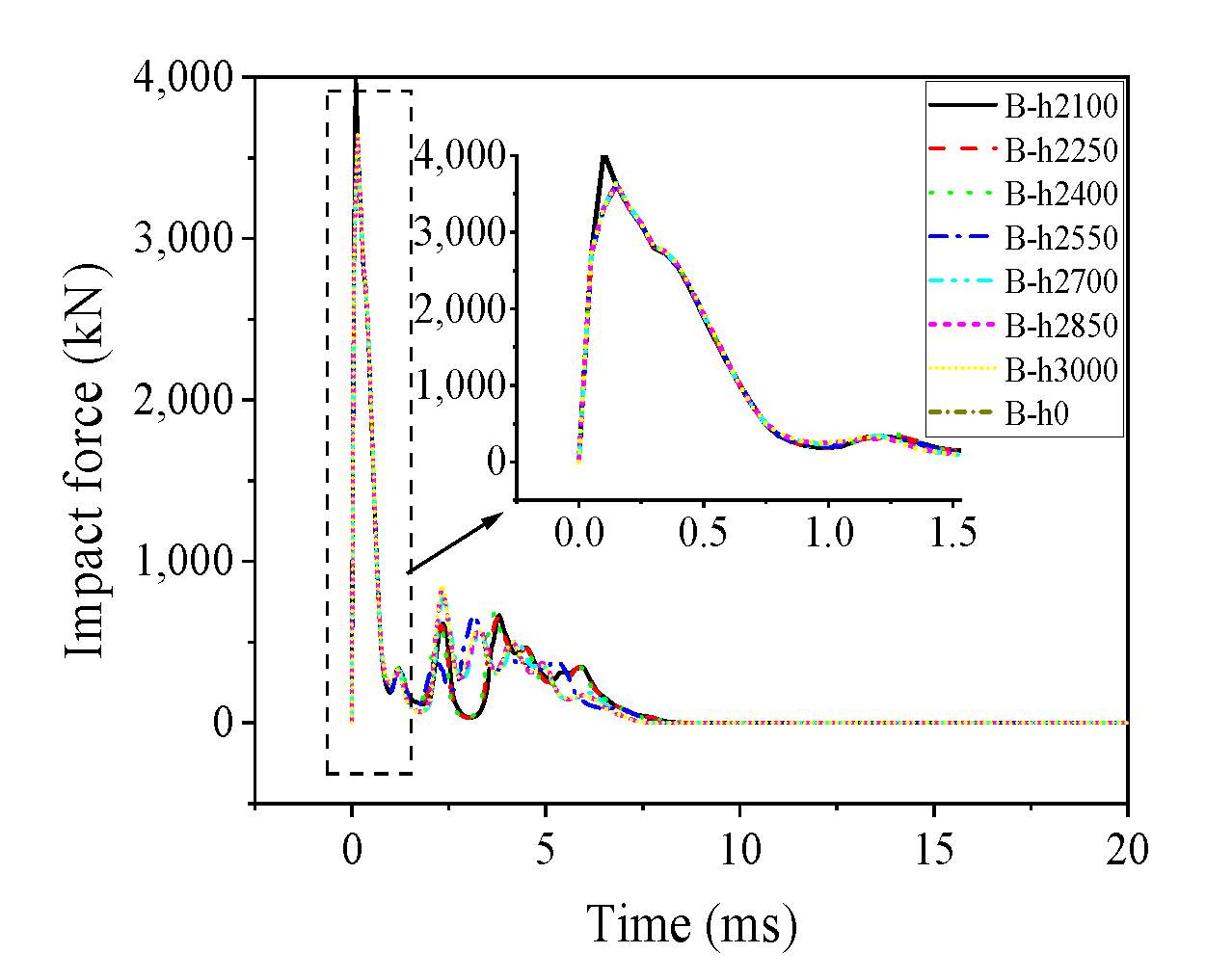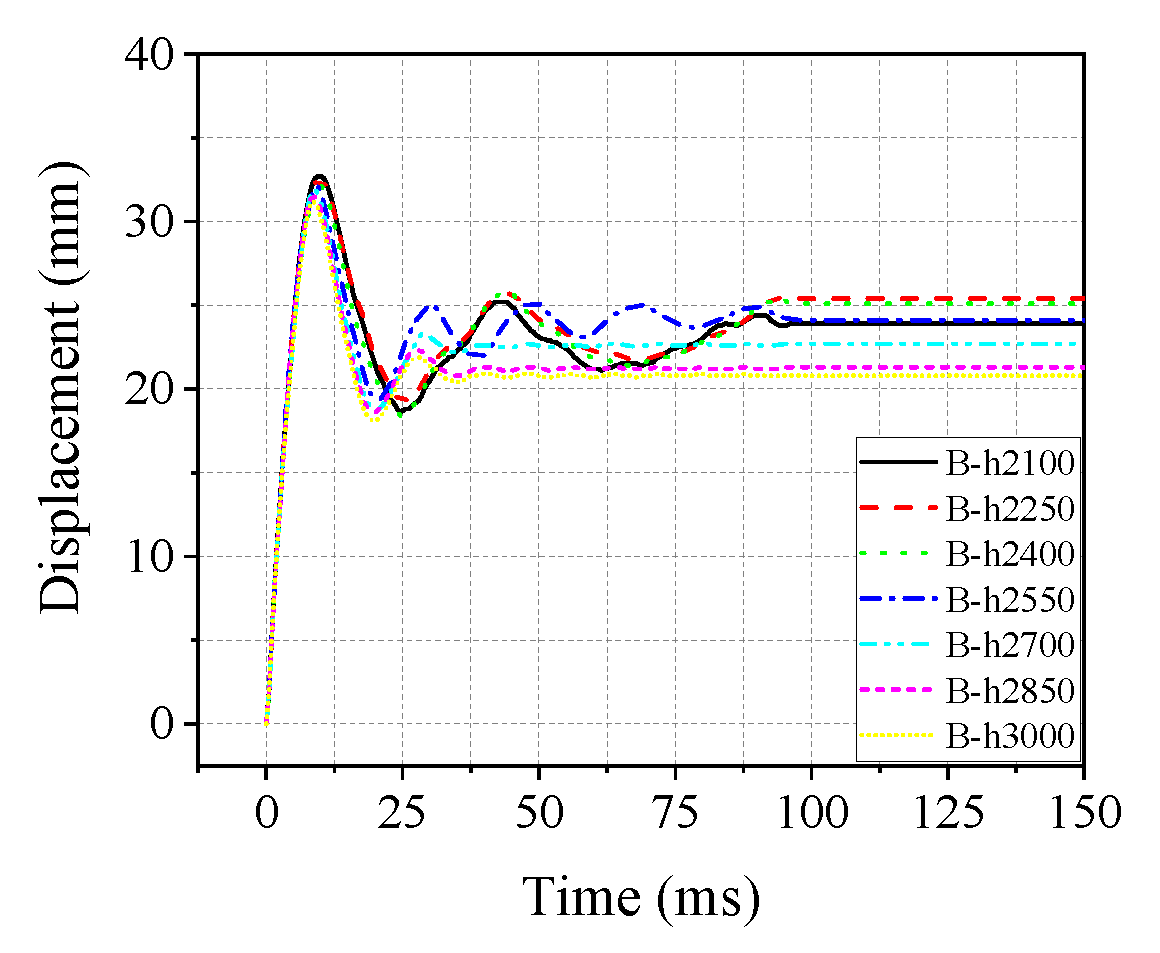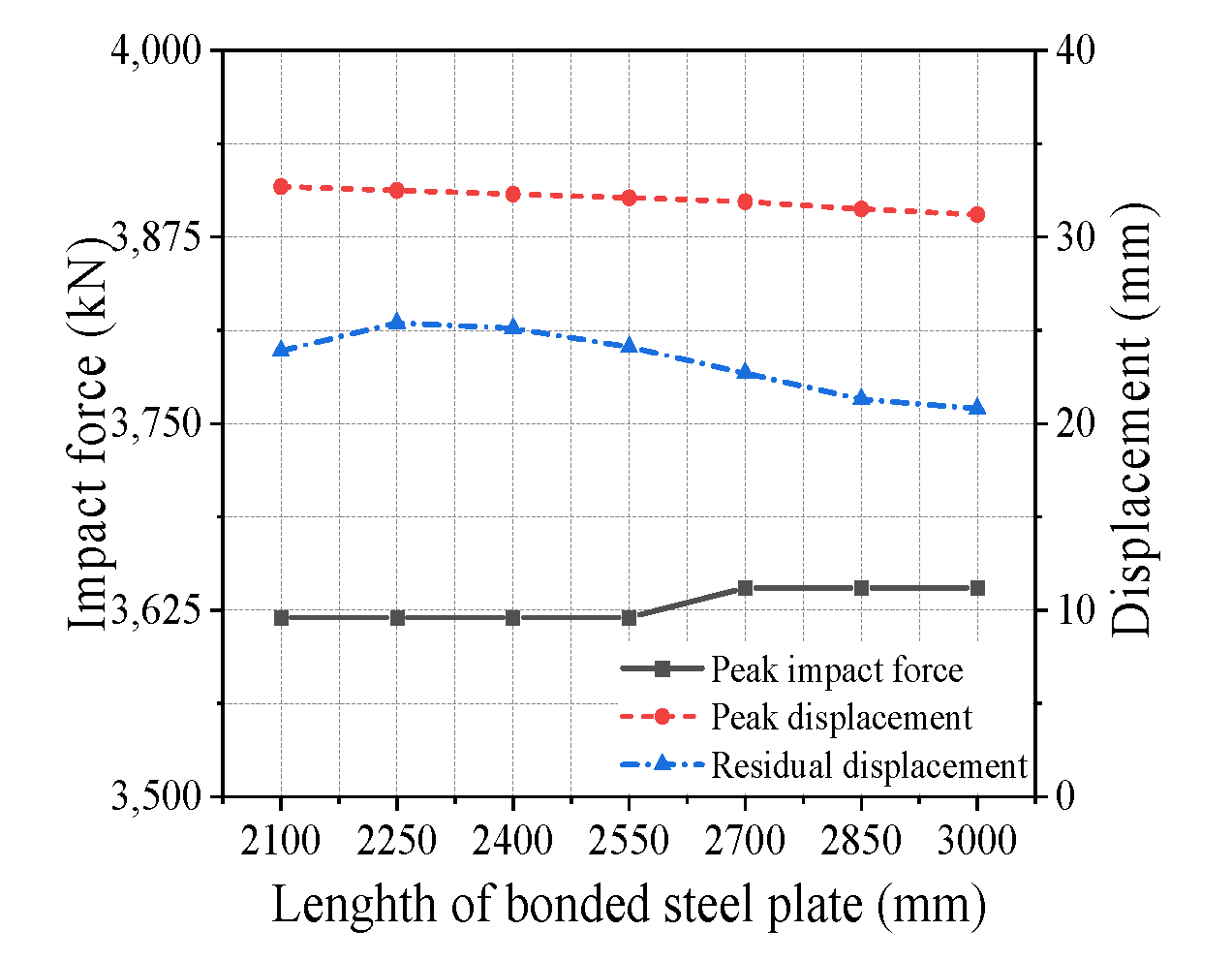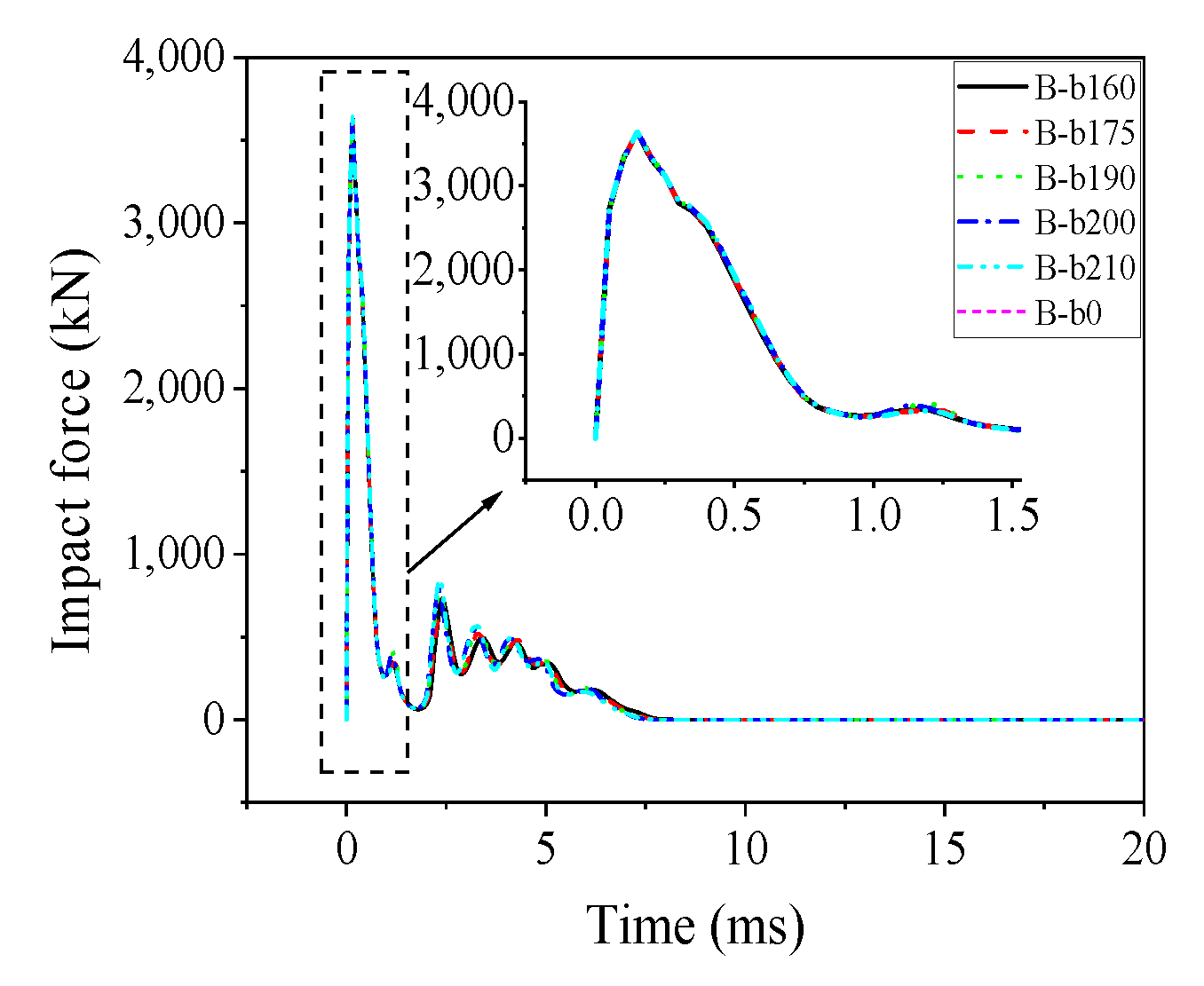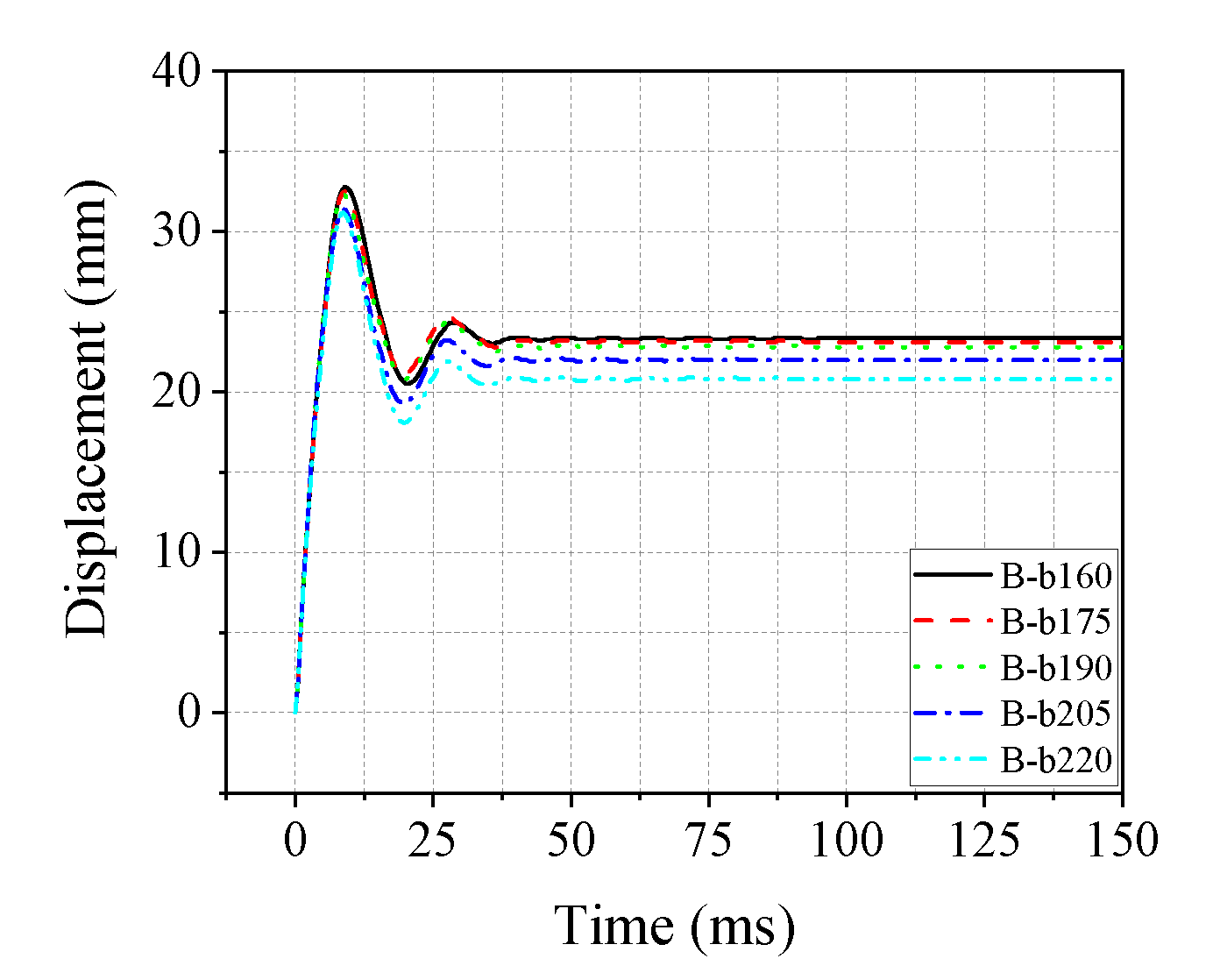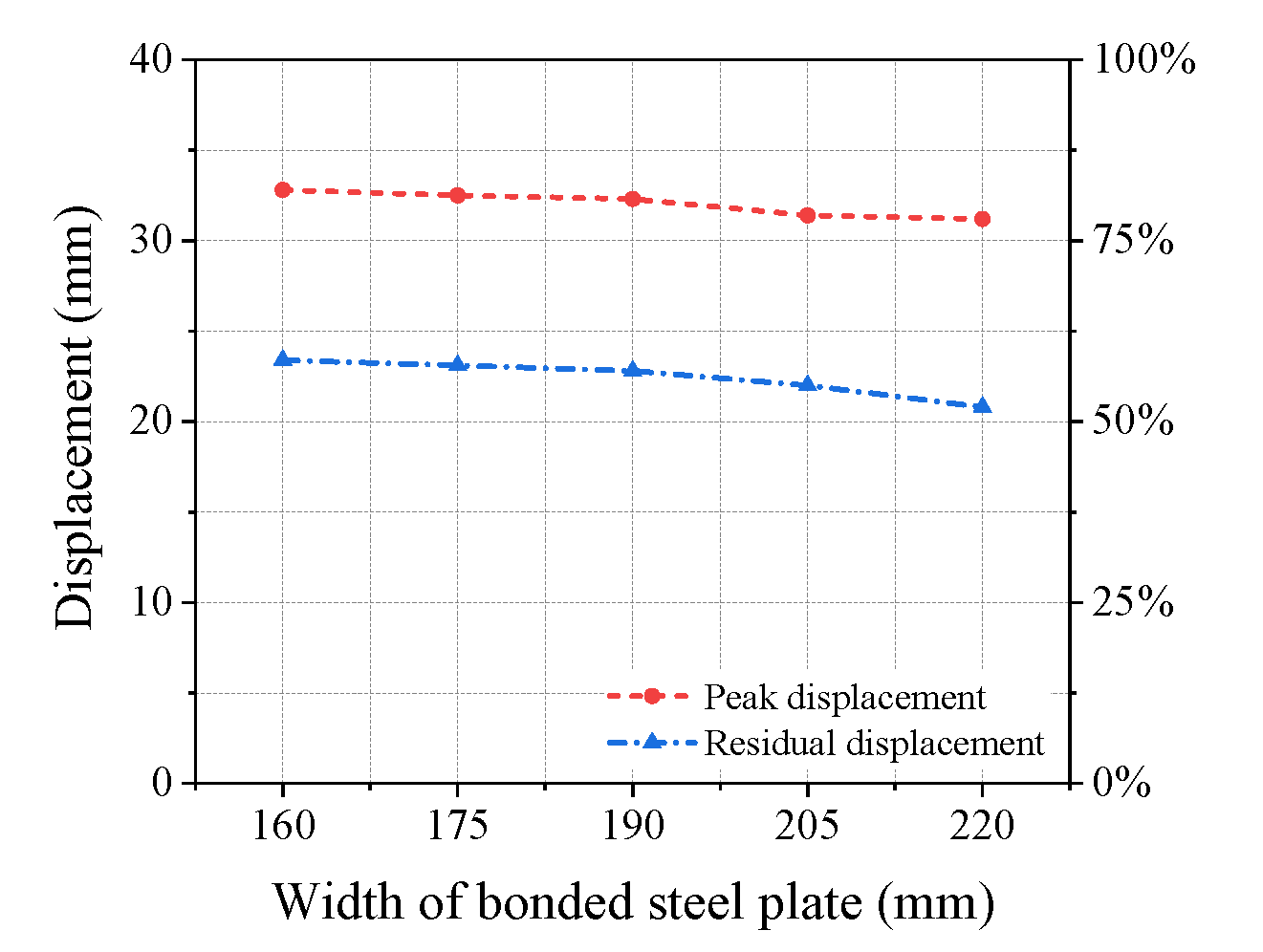Figure 1.
Schematic of the drop weight impact test setup.
Figure 1.
Schematic of the drop weight impact test setup.
Figure 2.
The details of the concrete and reinforcement for the PC beam: side view (unit: mm).
Figure 2.
The details of the concrete and reinforcement for the PC beam: side view (unit: mm).
Figure 3.
PC beam reinforcement welding joint positions: plane view (unit: mm).
Figure 3.
PC beam reinforcement welding joint positions: plane view (unit: mm).
Figure 4.
Reinforcement frame of the PC beam.
Figure 4.
Reinforcement frame of the PC beam.
Figure 5.
Splicing position of the PC beam.
Figure 5.
Splicing position of the PC beam.
Figure 6.
Drop-hammer impact model of the PC beam.
Figure 6.
Drop-hammer impact model of the PC beam.
Figure 7.
Energy conversion curve.
Figure 7.
Energy conversion curve.
Figure 8.
Comparison of the damage patterns.
Figure 8.
Comparison of the damage patterns.
Figure 9.
Comparison of the impact force–time history curves (beam B1).
Figure 9.
Comparison of the impact force–time history curves (beam B1).
Figure 10.
Comparison of the midspan displacement–time history curves (beam B1).
Figure 10.
Comparison of the midspan displacement–time history curves (beam B1).
Figure 11.
Comparison of the impact force−time history curves (beam A1).
Figure 11.
Comparison of the impact force−time history curves (beam A1).
Figure 12.
Comparison of the midspan displacement−time history curves (beam A1).
Figure 12.
Comparison of the midspan displacement−time history curves (beam A1).
Figure 13.
Comparison of the impact force−time history curves (beam B2).
Figure 13.
Comparison of the impact force−time history curves (beam B2).
Figure 14.
Comparison of the midspan displacement−time history curves (beam B2).
Figure 14.
Comparison of the midspan displacement−time history curves (beam B2).
Figure 15.
Comparison of the impact force−time history curves (beam B3).
Figure 15.
Comparison of the impact force−time history curves (beam B3).
Figure 16.
Comparison of the midspan displacement−time history curves (beam B3).
Figure 16.
Comparison of the midspan displacement−time history curves (beam B3).
Figure 17.
Equivalent plastic strain contours under different impact masses: (a) B-M130; (b) B-M180; (c) B-M230; (d) B-M280; (e) B-M330; (f) B-M380; (g) B-M430.
Figure 17.
Equivalent plastic strain contours under different impact masses: (a) B-M130; (b) B-M180; (c) B-M230; (d) B-M280; (e) B-M330; (f) B-M380; (g) B-M430.
Figure 18.
Impact force–time history curves under different impact masses.
Figure 18.
Impact force–time history curves under different impact masses.
Figure 19.
Midspan displacement–time history curves under different impact masses.
Figure 19.
Midspan displacement–time history curves under different impact masses.
Figure 20.
Variations of the dynamic response characteristic values under different impact masses.
Figure 20.
Variations of the dynamic response characteristic values under different impact masses.
Figure 21.
Equivalent plastic strain contours under different impact heights: (a) B-IH4; (b) B-IH5; (c) B-IH6; (d) B-IH7; (e) B-IH8; (f) B-IH9.
Figure 21.
Equivalent plastic strain contours under different impact heights: (a) B-IH4; (b) B-IH5; (c) B-IH6; (d) B-IH7; (e) B-IH8; (f) B-IH9.
Figure 22.
Impact force–time history curves under different impact heights.
Figure 22.
Impact force–time history curves under different impact heights.
Figure 23.
Midspan displacement–time history curves under different impact heights.
Figure 23.
Midspan displacement–time history curves under different impact heights.
Figure 24.
Variations of the dynamic response characteristic values under different impact heights.
Figure 24.
Variations of the dynamic response characteristic values under different impact heights.
Figure 25.
Equivalent plastic strain contours under different lengths of the bonded steel plates: (a) B-h2100; (b) B-h2250; (c) B-h2400; (d) B-h2550; (e) B-h2700; (f) B-h2850; (g) B-h3000.
Figure 25.
Equivalent plastic strain contours under different lengths of the bonded steel plates: (a) B-h2100; (b) B-h2250; (c) B-h2400; (d) B-h2550; (e) B-h2700; (f) B-h2850; (g) B-h3000.
Figure 26.
Impact force–time history curves under different lengths of the bonded steel plates.
Figure 26.
Impact force–time history curves under different lengths of the bonded steel plates.
Figure 27.
Midspan displacement–time history curves under different lengths of the bonded steel plates.
Figure 27.
Midspan displacement–time history curves under different lengths of the bonded steel plates.
Figure 28.
Variations of the dynamic response characteristic values under different lengths of the bonded steel plates.
Figure 28.
Variations of the dynamic response characteristic values under different lengths of the bonded steel plates.
Figure 29.
Equivalent plastic strain contours under different widths of the bonded steel plates: (a) B-h2100; (b) B-h2250; (c) B-h2400; (d) B-h2550; (e) B-h2700.
Figure 29.
Equivalent plastic strain contours under different widths of the bonded steel plates: (a) B-h2100; (b) B-h2250; (c) B-h2400; (d) B-h2550; (e) B-h2700.
Figure 30.
Impact force–time history curves under different widths of the bonded steel plates.
Figure 30.
Impact force–time history curves under different widths of the bonded steel plates.
Figure 31.
Midspan displacement–time history curves under different widths of the bonded steel plates.
Figure 31.
Midspan displacement–time history curves under different widths of the bonded steel plates.
Figure 32.
Peak impact force characteristic values under different widths of the bonded steel plates.
Figure 32.
Peak impact force characteristic values under different widths of the bonded steel plates.
Figure 33.
Peak displacement and residual displacement characteristic values under different widths of the bonded steel plates.
Figure 33.
Peak displacement and residual displacement characteristic values under different widths of the bonded steel plates.
Table 1.
Constitutive model parameters.
Table 1.
Constitutive model parameters.
| *MAT_RIGID | *MAT_PLASTIC_KINEMATIC | *MAT_CSCM_CONCRETE |
|---|
| Density/ | | Density/ | | Density/ | |
| Elastic modulus/E | 200,000 | Elastic modulus/E | 200,000 | Drawing options/NPLOT | 1 |
| Poisson’s ratio/ | 0.3 | Poisson’s ratio/ | 0.3 | Strain rate effect coefficient/RATE | 1 |
| Coupling control coefficient/N, COUPLE, M | 0, 0, 0 | Yield strength/SIGY | 427.45 | Elastic modulus coefficient of restitution/RECOV | 0 |
| Quality constraint factor/CMO, CON1, CON2 | 1, 7, 4 | Tangent modulus/ETAN | 2000 | Retraction coefficient of cap surface/ITRETRC | 0 |
| | | Hardening factor/β | 0 | Predamage factor/PRED | 0 |
| | | Strain rate factor/SRC, SRP | 40.4, 5 | Unconfined compressive strength/FPC | 25.5 |
| | | Failure strain/FS | 0.2 | Maximum particle size/DAGG | 25.0 |
| | | Strain rate effect algorithm/VP | 0 | Unit options/UNITS | 2 |
Table 2.
Summary of element types and material models.
Table 2.
Summary of element types and material models.
| Part Name | Prop Name | Material Model |
|---|
| Beam body | SOLID164 | *MAT_CSCM_CONCRETE |
| Hammer; support pad | SOLID164 | *MAT_RIGID |
| Longitudinal reinforcement; stirrup | BEAM161 | *MAT_PLASTIC_KINEMATIC |
| Steel plate; U-shaped steel plate hoops | SHELL163 | MAT_PLASTIC_KINEMATIC |
Table 3.
Comparison of the eigenvalues of dynamic responses.
Table 3.
Comparison of the eigenvalues of dynamic responses.
| ID | Peak Impact Force | Peak Midspan Displacement | Residual Value of Midspan Displacement |
|---|
| Test Value (kN) | Numerical Value (kN) | Error (%) | Test Value (mm) | Numerical Value (mm) | Error (%) | Test Value (mm) | Numerical Value (mm) | Error (%) |
|---|
| A1 | 3353 | 3672 | 9.51 | 33.6 | 33.7 | 0.30 | 29.8 | 29.9 | 0.34 |
| B1 | 3204 | 3648 | 13.8 | 32.6 | 32.6 | 0.00 | 21.0 | 21.5 | 2.38 |
| B2 | 3194 | 3640 | 14.0 | 31.4 | 31.2 | −0.64 | 21.0 | 20.8 | −0.95 |
| B3 | 3684 | 4060 | 10.2 | 31.7 | 31.7 | 0.00 | 20.3 | 20.7 | 1.97 |
Table 4.
Parameter influence analysis: impact mass.
Table 4.
Parameter influence analysis: impact mass.
| ID | Impact Mass (kg) | Peak Impact Force (kN) | Peak Midspan Displacement (mm) | Residual Value of Midspan Displacement (mm) |
|---|
| B-M130 | 130 | 3300 | 16.6 | 11.8 |
| B-M180 | 180 | 3480 | 22.1 | 14.8 |
| B-M230 | 230 | 3580 | 26.2 | 17.1 |
| B-M280 | 280 | 3640 | 31.2 | 20.8 |
| B-M330 | 330 | 3680 | 34.9 | 24.5 |
| B-M380 | 380 | 3720 | 38.1 | 27.6 |
| B-M430 | 430 | 3760 | 42.2 | 32.7 |
Table 5.
Parameter influence analysis: impact height.
Table 5.
Parameter influence analysis: impact height.
| ID | Impact Height (m) | Peak Impact Force (kN) | Peak Midspan Displacement (mm) | Residual Value of Midspan Displacement (mm) |
|---|
| B-IH4 | 4 | 3340 | 25.5 | 16.7 |
| B-IH5 | 5 | 3440 | 27.5 | 17.7 |
| B-IH6 | 6 | 3640 | 31.2 | 20.8 |
| B-IH7 | 7 | 3800 | 33.7 | 23.0 |
| B-IH8 | 8 | 3840 | 36.5 | 25.3 |
| B-IH9 | 9 | 3960 | 38.4 | 29.6 |
Table 6.
Parameter influence analysis: lengths of the bonded steel plates.
Table 6.
Parameter influence analysis: lengths of the bonded steel plates.
| ID | Length of Bonded Steel Plate (mm) | Peak Impact Force (kN) | Peak Midspan Displacement (mm) | Residual Value of Midspan Displacement (mm) |
|---|
| B-h2100 | 2100 | 3620 | 32.7 | 23.9 |
| B-h2250 | 2250 | 3620 | 32.5 | 25.4 |
| B-h2400 | 2400 | 3620 | 32.3 | 25.1 |
| B-h2550 | 2550 | 3620 | 32.1 | 24.1 |
| B-h2700 | 2700 | 3640 | 31.9 | 22.7 |
| B-h2850 | 2850 | 3640 | 31.5 | 21.3 |
| B-h3000 | 3000 | 3640 | 31.2 | 20.8 |
Table 7.
Parameter influence analysis: widths of the bonded steel plates.
Table 7.
Parameter influence analysis: widths of the bonded steel plates.
| ID | Width of Bonded Steel Plate (mm) | Peak Impact Force (kN) | Peak Midspan Displacement (mm) | Residual Midspan Displacement (mm) |
|---|
| B-b160 | 160 | 3640 | 32.8 | 23.4 |
| B-b175 | 175 | 3640 | 32.5 | 23.1 |
| B-b190 | 190 | 3640 | 32.3 | 22.8 |
| B-b205 | 205 | 3640 | 31.4 | 22.0 |
| B-b220 | 220 | 3640 | 31.2 | 20.8 |
Table 8.
Comparison of the peak impact force values between the working condition design and formula fitting.
Table 8.
Comparison of the peak impact force values between the working condition design and formula fitting.
| ID | Impact Mass (kg) | Impact Height (m) | Thickness of Bonded Steel Plate (mm) | Main Peak Value of the Impact Force (kN) | MAPE (kN) | Relative Error (%) |
|---|
| C1 | 280 | 4 | 4 | 3340 | 3328 | −0.36 |
| C2 | 280 | 5 | 4 | 3440 | 3495 | 1.59 |
| C3 | 280 | 6 | 4 | 3640 | 3637 | −0.07 |
| C4 | 280 | 7 | 4 | 3800 | 3762 | −0.99 |
| C5 | 280 | 8 | 4 | 3840 | 3874 | 0.89 |
| C6 | 280 | 9 | 4 | 3960 | 3976 | 0.39 |
| C7 | 130 | 6 | 4 | 3300 | 3360 | 1.81 |
| C8 | 180 | 6 | 4 | 3480 | 3475 | −0.15 |
| C9 | 230 | 6 | 4 | 3580 | 3564 | −0.45 |
| C10 | 330 | 6 | 4 | 3680 | 3700 | 0.54 |
| C11 | 380 | 6 | 4 | 3720 | 3754 | 0.92 |
| C12 | 430 | 6 | 4 | 3760 | 3802 | 1.13 |
| C13 | 280 | 6 | 1 | 3705 | 3707 | 0.05 |
| C14 | 280 | 6 | 2 | 3670 | 3672 | 0.05 |
| C15 | 280 | 6 | 3 | 3650 | 3652 | 0.05 |
| C16 | 280 | 6 | 5 | 3622 | 3626 | 0.12 |
| C17 | 280 | 6 | 6 | 3601 | 3617 | 0.45 |
Table 9.
Comparison of the midspan displacements between the working condition design and formula fitting.
Table 9.
Comparison of the midspan displacements between the working condition design and formula fitting.
| ID | Impact Mass (kg) | Impact Height (m) | Thickness of Bonded Steel Plate (mm) | Length of Bonded Steel Plate (MPa) | Width of Bonded Steel Plate (mm) | Peak Midspan Displacement (mm) | MSE (mm) | Relative Error (%) | Residual Value of Midspan Displacement (mm) | RMSE (mm) | Relative Error (%) |
|---|
| W1 | 280 | 4 | 4 | 3000 | 220 | 25.5 | 24.8 | −2.7 | 16.7 | 15.9 | −5.0 |
| W2 | 280 | 5 | 4 | 3000 | 220 | 27.5 | 28.0 | 1.8 | 17.7 | 18.7 | 5.4 |
| W3 | 280 | 6 | 4 | 3000 | 220 | 31.2 | 30.9 | −1.0 | 20.8 | 21.3 | 2.4 |
| W4 | 280 | 7 | 4 | 3000 | 220 | 33.7 | 33.6 | −0.4 | 23 | 23.8 | 3.5 |
| W5 | 280 | 6 | 4 | 3000 | 220 | 36.5 | 36.1 | −1.2 | 25.3 | 26.2 | 3.7 |
| W6 | 280 | 9 | 4 | 3000 | 220 | 38.4 | 38.4 | 0.1 | 29.6 | 28.6 | −3.5 |
| W7 | 130 | 6 | 4 | 3000 | 220 | 16.6 | 17.4 | 5.0 | 11.8 | 10.9 | −7.6 |
| W8 | 180 | 6 | 4 | 3000 | 220 | 22.1 | 22.2 | 0.5 | 14.8 | 14.2 | −3.8 |
| W9 | 230 | 6 | 4 | 3000 | 220 | 26.2 | 26.7 | 1.8 | 17.1 | 17.8 | 4.1 |
| W10 | 330 | 6 | 4 | 3000 | 220 | 34.9 | 34.9 | 0.1 | 24.5 | 24.7 | 0.9 |
| W11 | 380 | 6 | 4 | 3000 | 220 | 38.1 | 38.8 | 1.8 | 27.6 | 28.1 | 1.9 |
| W12 | 430 | 6 | 4 | 3000 | 220 | 42.2 | 42.5 | 0.8 | 32.7 | 31.5 | −3.7 |
| W13 | 280 | 6 | 1 | 3000 | 220 | 33.2 | 33.6 | 1.1 | 25.2 | 24.4 | −3.0 |
| W14 | 280 | 6 | 2 | 3000 | 220 | 32.6 | 32.2 | −1.2 | 21.5 | 22.8 | 6.1 |
| W15 | 280 | 6 | 3 | 3000 | 220 | 31.9 | 31.4 | −1.5 | 21.2 | 21.9 | 3.3 |
| W16 | 280 | 6 | 5 | 3000 | 220 | 30.5 | 30.5 | −0.1 | 20.7 | 20.8 | 0.6 |
| W17 | 280 | 6 | 6 | 3000 | 220 | 29.9 | 30.2 | 0.8 | 20.6 | 20.4 | −0.7 |
| W18 | 280 | 6 | 4 | 2100 | 220 | 32.7 | 33.0 | 0.9 | 23.9 | 25.6 | 7.0 |
| W19 | 280 | 6 | 4 | 2250 | 220 | 32.5 | 32.6 | 0.2 | 25.4 | 24.7 | −2.9 |
| W20 | 280 | 6 | 4 | 2400 | 220 | 32.3 | 32.2 | −0.4 | 25.1 | 23.9 | −4.9 |
| W21 | 280 | 6 | 4 | 2550 | 220 | 32.1 | 31.8 | −0.8 | 24.1 | 23.1 | −4.0 |
| W22 | 280 | 6 | 4 | 2700 | 220 | 31.9 | 31.5 | −1.3 | 22.7 | 22.5 | −1.0 |
| W23 | 280 | 6 | 4 | 2850 | 220 | 31.5 | 31.2 | −1.0 | 21.3 | 21.9 | 2.6 |
| W24 | 280 | 6 | 4 | 3000 | 160 | 32.8 | 33.1 | 0.8 | 23.4 | 23.7 | 1.3 |
| W25 | 280 | 6 | 4 | 3000 | 175 | 32.5 | 32.4 | −0.2 | 23.1 | 23.0 | −0.5 |
| W26 | 280 | 6 | 4 | 3000 | 190 | 32.3 | 31.9 | −1.3 | 22.8 | 22.4 | −1.9 |
| W27 | 280 | 6 | 4 | 3000 | 205 | 31.4 | 31.4 | −0.1 | 22 | 21.8 | −0.9 |
